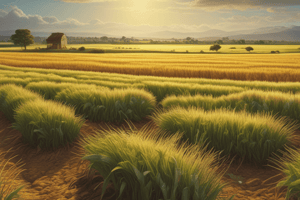Podcast
Questions and Answers
What is the purpose of determining the crop management factor C?
What is the purpose of determining the crop management factor C?
To reflect the combined effect of various crop management practices.
How is the factor C computed for a particular crop?
How is the factor C computed for a particular crop?
By computing the ratio of soil loss from cropped plot to the corresponding soil loss from a continuous fallow land for each crop stage separately.
What does the value of factor C indicate?
What does the value of factor C indicate?
It reflects the effectiveness of crop management practices in reducing soil loss.
How is the Support Practice Factor (P) defined?
How is the Support Practice Factor (P) defined?
Explain the difference between Period 2 and Period 3 in the crop growth stages.
Explain the difference between Period 2 and Period 3 in the crop growth stages.
What is Period 4, as mentioned in the text?
What is Period 4, as mentioned in the text?
What is the formula for calculating the LS factor according to Wischmeier and Smith (1962)?
What is the formula for calculating the LS factor according to Wischmeier and Smith (1962)?
How is the LS factor calculated in the M.K.S. system based on the observations mentioned by Wischmeier and Smith (1978)?
How is the LS factor calculated in the M.K.S. system based on the observations mentioned by Wischmeier and Smith (1978)?
Define the crop management factor C.
Define the crop management factor C.
How is erosion control effectiveness evaluated for different crops and cropping practices?
How is erosion control effectiveness evaluated for different crops and cropping practices?
What does the period 1 (Seed Bed) refer to in the evaluation of erosion control effectiveness?
What does the period 1 (Seed Bed) refer to in the evaluation of erosion control effectiveness?
How do crops and cropping practices impact soil erosion?
How do crops and cropping practices impact soil erosion?
What are the sub-factors used to calculate the cover management term (C) in the Modified Universal Soil Loss Equation (MUSLE)?
What are the sub-factors used to calculate the cover management term (C) in the Modified Universal Soil Loss Equation (MUSLE)?
How was the USLE modified to create the Modified Universal Soil Loss Equation (MUSLE)?
How was the USLE modified to create the Modified Universal Soil Loss Equation (MUSLE)?
What does the MUSLE equation help model in terms of sediment yield?
What does the MUSLE equation help model in terms of sediment yield?
Why is the MUSLE considered advantageous from a modeling perspective?
Why is the MUSLE considered advantageous from a modeling perspective?
What does the peak rate of runoff (qp) represent in the MUSLE equation?
What does the peak rate of runoff (qp) represent in the MUSLE equation?
How does the MUSLE model contribute to increasing sediment yield prediction accuracy?
How does the MUSLE model contribute to increasing sediment yield prediction accuracy?
Flashcards are hidden until you start studying




